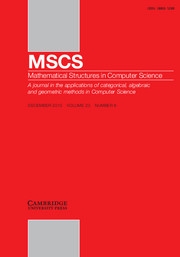Crossref Citations
This article has been cited by the following publications. This list is generated based on data provided by Crossref.
Galmiche, D.
and
Notin, J.M.
2000.
Proof-search and Proof Nets in Mixed Linear Logic.
Electronic Notes in Theoretical Computer Science,
Vol. 37,
Issue. ,
p.
1.
Galmiche, Didier
and
Pym, David J.
2000.
Proof-search in type-theoretic languages: an introduction.
Theoretical Computer Science,
Vol. 232,
Issue. 1-2,
p.
5.
Delzanno, Giorgio
and
Martelli, Maurizio
2001.
Proofs as computations in linear logic.
Theoretical Computer Science,
Vol. 258,
Issue. 1-2,
p.
269.
Longo, Giuseppe
2020.
Handbook of the Mathematics of the Arts and Sciences.
p.
1.
Longo, Giuseppe
2021.
Handbook of the Mathematics of the Arts and Sciences.
p.
2459.

